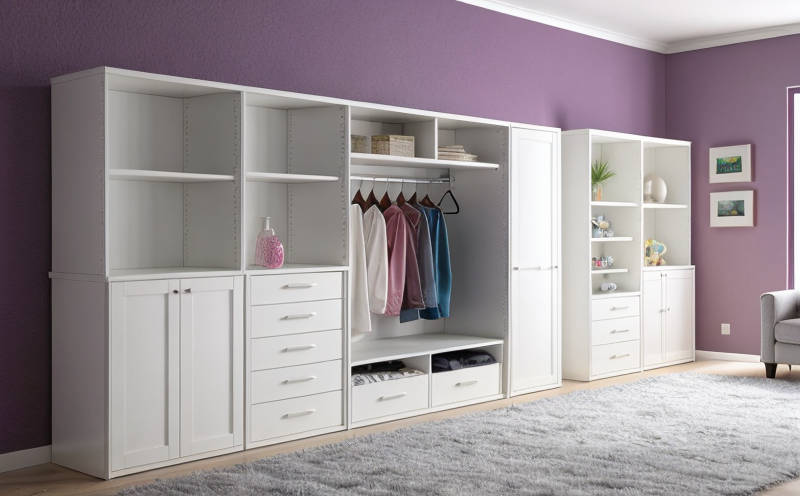DIN 68861 Furniture Surfaces Resistance Testing for Wardrobes and Shelves
The DIN standard DIN 68861 specifies the method for determining the resistance of furniture surfaces to mechanical stress, which is particularly important for storage furniture like wardrobes and shelves. This testing ensures that these items can withstand normal use without damage or failure. The standard applies not only to wooden but also to synthetic materials commonly used in modern furniture design.
Storage furniture, especially wardrobe units and shelving systems, are subjected to various types of mechanical stress during their lifecycle. These stresses include but are not limited to:
- Load from clothing or other stored items
- Opening and closing actions that exert torsional forces on hinges and pivots
- Potential impacts from accidental knocks or falls
- Environmental factors such as temperature changes which can affect the material's durability over time
DIN 68861 provides a standardized approach to evaluating how well these surfaces perform under simulated real-world conditions. By adhering to this standard, manufacturers ensure that their products meet quality benchmarks set by industry leaders and regulatory bodies.
The test procedure involves subjecting samples cut from actual furniture parts to specific loading cycles designed to mimic typical usage scenarios. The results provide valuable insights into the structural integrity of the tested materials under dynamic conditions rather than relying solely on static load tests.
| Test Parameter | Description |
|---|---|
| Loading Cycle | A series of defined compressive loads applied at regular intervals to simulate everyday use patterns. |
| Material Type | Both natural woods and engineered boards can be tested, allowing manufacturers flexibility in material selection based on performance requirements. |
| Specimen Size | Standardized dimensions ensure consistent results across different samples and facilities. |
| Data Collection | Instruments record critical parameters like force applied vs displacement, providing detailed information about the material's behavior during testing. |
This comprehensive evaluation helps identify potential weaknesses in design or manufacturing processes early on, enabling improvements that enhance product reliability and safety. Compliance with DIN 68861 also supports manufacturers in meeting customer expectations regarding durability and longevity of their products.
Our laboratory offers advanced facilities equipped to conduct DIN 68861 testing according to precise specifications outlined by the standard. Contact us today if you're interested in learning more about our services or scheduling a test run on your product prototypes.
Why It Matters
The importance of ensuring furniture surfaces have adequate resistance cannot be overstated, especially for storage units like wardrobes and shelves. These pieces are integral to daily life, often holding valuable personal belongings or essential items that require safekeeping over extended periods.
Non-compliance with standards like DIN 68861 can lead to several negative consequences:
- Potentially hazardous situations if structural failure occurs due to excessive stress
- Economic losses resulting from premature replacement of damaged furniture
- Damage to stored items, leading to additional costs and inconvenience for end users
- Reputation damage for brands associated with substandard products
On the positive side, compliance brings numerous benefits:
- Enhanced reputation among consumers who prioritize quality assurance
- Increased market share by offering superior value propositions
- Potential cost savings through improved design iterations before full-scale production
- Improved safety standards protecting users from accidents or injuries
In summary, adhering to DIN 68861 is not just a regulatory requirement; it's an investment in long-term success and customer satisfaction.
Applied Standards
DIN 68861 specifies the method for determining resistance of furniture surfaces to mechanical stress. This standard covers various aspects including loading methods, specimen preparation, testing procedures, data analysis techniques, and acceptance criteria.
| Standard Clause | Description |
|---|---|
| DIN 68861-1 | Introduction to the standard including scope and definitions |
| DIN 68861-2 | Methodology for testing load capacity under static loads |
| DIN 68861-3 | Procedure for assessing dynamic loading effects using cyclic tests |
| DIN 68861-4 | Data analysis and interpretation guidelines for interpreting test results |
| DIN 68861-5 | Acceptance criteria based on predefined performance targets |
The application of these clauses ensures that all relevant factors are considered during the testing process, ensuring accurate and reliable results. Compliance with DIN 68861 guarantees adherence to rigorous quality standards recognized globally.
Benefits
Adhering to DIN 68861 brings multiple benefits that contribute significantly to both product development and customer satisfaction:
- Enhanced Quality Assurance: Rigorous testing ensures that only high-quality materials and designs reach the market.
- Informed Decision Making: Detailed reports provide insights into material properties, enabling better design choices.
- Improved User Safety: Ensures that furniture components do not pose risks to users through structural failures.
- Increased Market Confidence: Meeting international standards boosts consumer trust and brand reputation.
- Cost Efficiency: Early identification of issues reduces rework costs and enhances overall production efficiency.
- Promotes Innovation: Understanding material limitations drives continuous improvement in design and materials science.
In essence, compliance with DIN 68861 supports a holistic approach to furniture manufacturing that prioritizes both functional excellence and safety standards.





